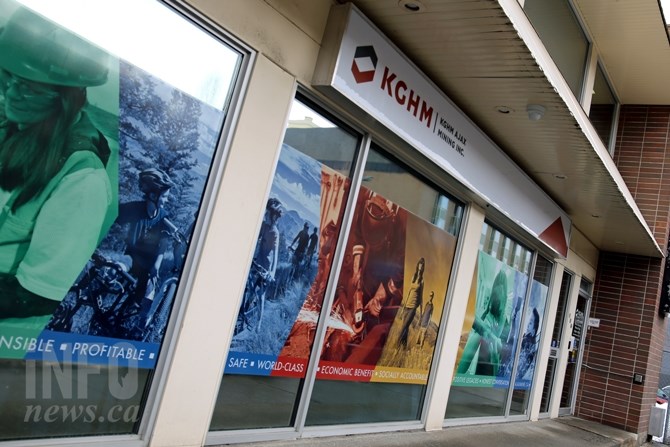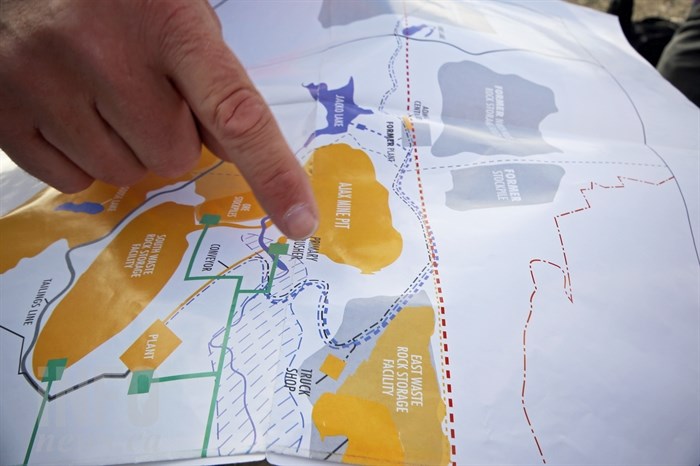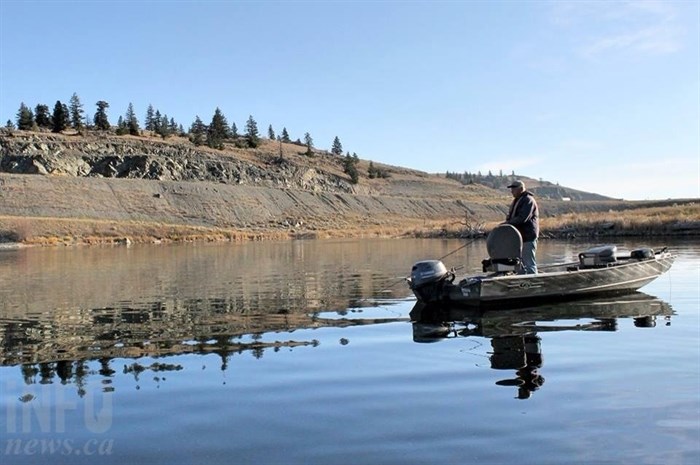
(JENNIFER STAHN / iNFOnews.ca)
January 19, 2016 - 9:00 AM
KAMLOOPS - The environmental application is finally submitted and now the reading, reviews and scrutinizing begins for a project the mine calls an ‘opportunity of a lifetime’ for Kamloops.
KGHM Ajax Mining has officially submitted its 18,000-page application for the proposed mine, making the application package available online and KGHM’s plain language summaries went live late Monday afternoon. Those summaries will also be available for viewing in its Seymour Street office, at City Hall and at both Kamloops libraries.
We will be taking a look at different elements of the application throughout the week. We’ve already looked at the air quality and human health reports and now we’ll look at the changes made to the footprint, delays the project has already faced and how long the company thinks it will be before construction can begin.
TAILING STORAGE AND OTHER ALTERNATIVES

(JENNIFER STAHN / iNFOnews.ca)
The current footprint of the mine site has changed significantly from where it started several years ago. External Affairs Manager Yves Lacasse calls the changes ‘significant’ and notes the company spent more than $100 million to make those changes.
Lacasse says the changes, announced in May 2014 that moved parts of the mine farther away from both the city and the Coquihalla Highway, were a direct result of the company listening to feedback from the community.
“Evidence of that, where we were three or four years ago and where we are now… is in the general arrangement. (The changes) weren’t made because of the company, they were made because of the feedback of the community,” Lacasse says. “I think we have demonstrated that we are willing to listen and we do care.”
Those changes came several months after the company was first planning to submit its environmental application. Originally planning on a fall 2013 submission, the company pushed back the date to allow for a change in footprint, which led to reviewing of the application requirements and more studies.
The plain language summary on ‘alternative means’ outlines how the company reviewed alternatives and made changes, most notably to the tailings storage. KGHM looked at the economic feasibility of the option as well as if the option could actually be accomplished.
The company looked at 17 different alternatives for things such as mining methods, rate of ore processing, power supply and road access, and in the end four major alternatives were considered for the project.
The company shifted the layout and reduced the overall size, in addition to changing the dry stacking storage to ‘thickened tailings disposal’ for tailings. By using wet tailings the company says it will reduce the amount of water being used while still allowing the tailings to be pumped, which is safer for people and the environment, and more suitable to the size of the project. This change will include using mine rock to increase the strength of the facility beyond minimum requirements, reducing the risk of a breach, and improving air quality by reducing the amount of fine particulate that can get into the air.
Reclamation will offer reduced challenges with the new layout as well. The company has looked at designs for the closure of the tailings storage facility and says it plans to fill the pit with rock solids and cover with soil, which will allow grasses and native plants to grow. Water will be directed away from the site until it reaches water quality guidelines, at which point it will be connected with Humphrey Creek.
FIRST NATIONS CLAIM ON JACKO LAKE

(GLYNN BROTHEN / iNFOnews.ca)
Another possible delay is the recent claim local First Nations have made on the Jacko Lake area.
A declaration of land title was made in June 2015 and by September, Stk’emlupsemc te Secwepemc Nation, a group representing the members of Tk’emlups and Skeetchestn First Nations, had officially filed an Aboriginal rights and title claim for the Jacko Lake property with the Supreme Court of B.C.
Lacasse says they continue to work with First Nations on the claim and studies taking place on the work site. They’ve also had technical and negotiation meetings with representatives and hope to soon have an agreement in place.
“The meetings we’ve been having have been very productive… the dialogue has changed over the last few months,” he says.
Project Manager Clyde Gillespie notes it’s important for them to have a working relationship with First Nations and the company plans on continuing to put a lot of energy into those relationships.
Gillespie says it’s too early to know if the land dispute will have an impact on timelines, but he is hopeful that once permits are in place there will be an agreement also in place with First Nations.
“We’re confident we can work out a resolution,” he says.
COMMODITY PRICES AND A LOW CANADIAN DOLLAR

(JENNIFER STAHN / iNFOnews.ca)
While the low Canadian dollar is good for business, the low commodity prices are not.
Gillespie says if they had figured the current exchange rate into their economic reports it would be ‘very favourable’ for the company, but admits it is a bit uncertain where the commodity price will be once operations are ready to begin.
“We hope we catch the upswing,” he says. “It’s cyclical and we’re in the downswing right now, but we know those prices will recover…. What we’re hopeful for is an improved copper and gold price, and hope we’re in a position to take advantage of it when they do improve.”
While the company could be ready to put a shovel in the ground as soon as the application is approved — if it’s approved — and permits are secured, Gillespie says they have about three years to start construction.
Either way the company is excited to be on to the next step and is confident in the application they have put forward.
“This is a really exciting time for us, to finally submit and have the opportunity to have real conversation in the community based on science, not just innuendos and fear mongering,” Lacasse says. “Staff internally is really excited and looks forward to the next few months.”
Lacasse notes staff spent a lot of time preparing the plain language summaries, which are intended to help the public better understand the pieces of the application they are interested in.
“We wanted it to be completely transparent,” he says, noting it is not intended to gloss over the application to make the project look more appealing. “Most is cut and paste from the actual report.”
The company will take part in open houses being put on by the Environmental Assessment Office, which are expected to take place mid-February, and will also be offering information sessions to neighbourhood and community groups. The city is also planning open houses and KGHM will have fact sheets available for a broad overview of certain topics.
For more stories on the proposed Ajax Mine, an open-pit copper and gold mine set to operate just southwest of Kamloops, if approved, click here.
To contact a reporter for this story, email Jennifer Stahn at jstahn@infonews.ca or call 250-819-3723. To contact an editor, email mjones@infonews.ca or call 250-718-2724.
News from © iNFOnews, 2016